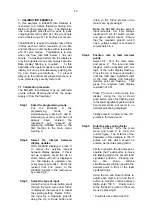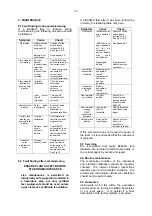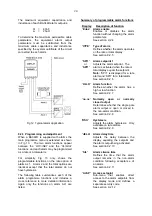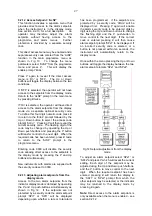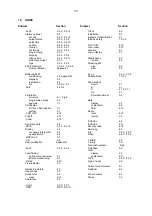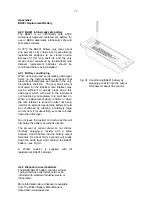
26
9.2.6 Setpoint adjustment: ‘SPx1’ and
‘SPx2’
The rate alarm setpoints SPr1 and SPr2 may
be positioned anywhere between 0 and
999999, and the total alarm setpoint SPt1 and
SPt2 anywhere between 00000000 and
99999999.
To adjust the setpoint of alarm 1 select 'SPr1'
or ‘SPt1’, depending upon how it has been
programmed, from the alarm menu. Press
P
which will reveal the existing value with one
digit flashing. Each digit of the setpoint can be
adjusted using the
Up
and
Down
push-buttons,
and the
P
button to move to the next digit. The
position of the decimal point is defined by the
d.P. function which should be set first. When
the required value has been entered press
E
to return to the alarm menu.
Note:
‘SPr1’ is displayed when alarm 1 has
been programmed as a rate alarm and ‘SPt1’
when programmed as a total alarm.
9.2.7 Alarm function: ‘HI.LO’
Each alarm must be conditioned as a high or
low alarm. To check or change the alarm
function select 'HI.LO' from the alarm menu
and press
P
to reveal the current setting. The
function can be changed by pressing the
Up
or
Down
buttons followed by the
E
button to
return to the alarm menu.
9.2.8 Alarm output status: ‘no.nc’
The two alarm outputs may be open or closed
in the non-alarm condition. When the BA344D
power supply is turned off or disconnected,
both the alarm outputs will open irrespective of
whether normally open or normally closed
outputs have been selected. Therefore, when
designing an alarm system, normally closed
‘nc’ should be selected so that the output
opens when an alarrm occurs or if the power
supply fails.
To check the alarm output status select 'no.nc'
from the alarm menu and press
P
to reveal the
current setting. The function can be changed
by pressing the
Up
or
Down
button followed by
the
E
button to return to the alarm menu.
9.2.9 Hysteresis: ‘HStr’
Hysteresis is only available on rate alarms.
During programming hysteresis is shown in the
units of rate the BA344D has been calibrated
to display.
To adjust the hysteresis, select 'HStr' from the
alarm menu and press
P
which will reveal the
existing figure. Each digit can be adjusted
using the
Up
and
Down
push-buttons, and the
P
button to move to the next digit. When the
required hysteresis has been entered, press
E
to return to the alarm menu.
e.g. A BA344D calibrated to display a flow of 0
to 5000, with a high alarm set at 4000 and
hysteresis of 100 will perform as follows:
High alarm will be activated when flow
equals or exceeds 4000, but will not reset
until the flow falls below 3900.
9.2.10 Alarm delay: ‘dELA’
This function enables activation of the alarm
output to be delayed for a fixed time following
the alarm condition being detected. The delay
can be programmed in 1 second increments up
to 3600 seconds. If a delay is not required
zero should be entered. To adjust the delay
select 'dELA' from the alarm menu and press
P
which will reveal the existing delay time. Each
digit of the delay can be adjusted using the
Up
and
Down
push-buttons, and the
P
button to
move to the next digit. When the required
delay has been entered, press
E
to return to
the alarm menu.
The alarm annunciator will start flashing
immediately an alarm is detected and continue
for the delay time after which the alarm output
will be activated.
9.2.11 Alarm silence time: ‘SIL’
The alarm silence function is primarily intended
for use in small installations where the alarm
output directly operates an annunciator such
as a sounder. When the alarm silence time is
set to any figure other than zero, the
P
push-
button becomes an alarm accept button.
After an alarm has occurred, operating the
P
button will cause the alarm output to revert to
the non-alarm condition for the programmed
alarm silence time. When an alarm is silenced
the alarm annunciator will flash until the silence
time expires.
To adjust the silence time select 'SIL' from the
alarm menu and press
P
which will reveal the
existing time. The time may be adjusted to
between 0 and 3600 seconds in 1 second
increments. Each digit can be adjusted using
the
Up
and
Down
push-buttons, and the
P
button transfers control to the next digit. When
the required time has been entered press
E
to
return to the alarm menu.
Summary of Contents for BA344D
Page 13: ...13...








